1966/1967 Instrument Cluster Identification
Go to the Adding Aftermarket Gauges to a 1966/1967 Cluster page...
There are several basic instrument clusters for both 1966 and 1967. A 1967 basic instrument cluster can be easily spotted by the presence of the high beam indicator on the speedometer face.
1966
The standard gauge cluster for a 1966 Chevelle Malibu or SS396 consisted of the fuel gauge on the left and clock on the right. This example is for a column shifted automatic transmission Chevelle as noted by the small window below the speedometer to show the gear selection indicator. A column shifted manual transmission would not have this window but would look like the 2nd photo.


The 300 & 300 Deluxe did not have the clock as standard equipment but the clock was available under RPO U35. On a Malibu or SS396 when bucket seats and a console were ordered the clock automatically moved to the console and the blank plate was used instead of the clock. When bucket seats were ordered but no console on a Malibu or SS396, the cluster retained the clock.

Shown below is a matrix of the location of the clock based on series, console or not, and RPO U14 Special Instrumentation ordered or not.
I should be noted that in 1966 the RPO U14 Special Instrumentation option was available on any Malibu sport coupe, convertible or pickup with any L6 or V8 engine and any SS396 sport coupe or convertible. When ordered with any V8 engine a tachometer was included in the package. The tachometer could be ordered separately (without the RPO Special Instrumentation package) under RPO U16 and is shown to be available on any V8 regardless of series.
| 1966/1967Chevelle Series/Model | Clock location |
| 1966 | |
| 300/300 Deluxe-column shift-console not available | optional-located in cluster when ordered |
| Malibu/SS396-column shift -no console-no gauges | Clock in cluster |
| SS396-floor mounted 3-speed-no console-no gauges | Clock in cluster |
| Malibu/SS396-floor mounted shift with console-no gauges | Clock in console |
| Malibu/SS396-column shift-no console-gauges | Clock on top of dash |
| SS396-floor mounted 3- or 4-speed shift -no console-gauges | Clock on top of dash |
| Malibu/SS396-floor mounted shift with console-gauges | Clock in console |
| 1967 - same as above with the following exceptions | |
| Malibu V8*/SS396-column shift-no console-gauges | Clock on top of transmission tunnel |
| SS396-floor mounted 3- or 4-speed shift -no console-gauges | Clock on top of transmission tunnel |
* For 1967, RPO U14 was only available when a V8 engine was ordered in a Malibu sport coupe, convertible, or pickup.
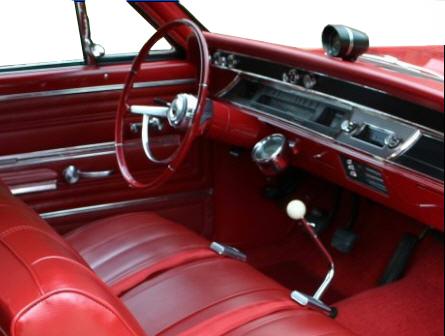
1966 Chevelle with manual transmission floor shift, no console but with RPO U14.
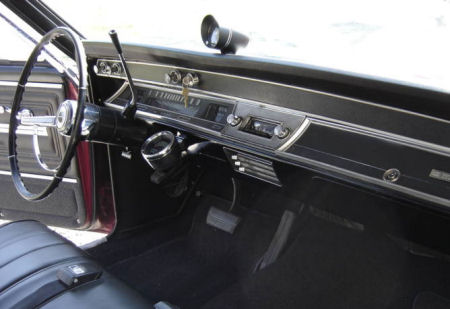
1966 Chevelle with automatic transmission column shift, no console but with RPO U14.
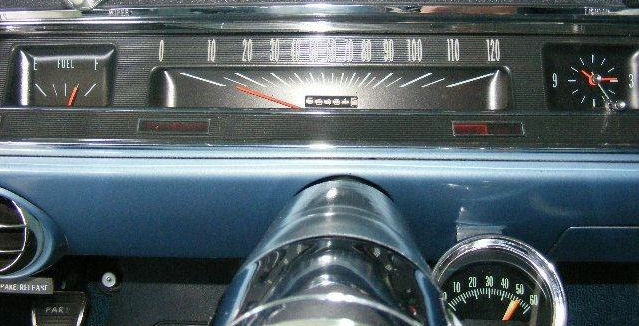
1966 Chevelle with RPO U16 tachometer only option. The tachometer was located on the lower dash panel and often interfered with the driver's right knee earning it the nickname of "knee-knocker" tach and was available on any V8 series or model with a V8 engine.
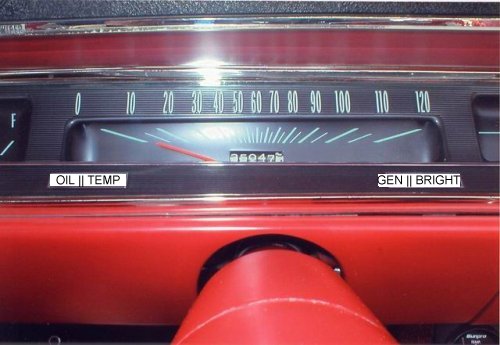
The standard warning lamps for 1966 included, from left to right, oil pressure, water temperature, generator, and bright (high beam headlight) lamps. When the RPO U14 Special Instrumentation was ordered naturally three of these warning lamps, oil pressure, water temperature and generator were no longer necessary.

The OIL||TEMP pair of warning lamps gave way to a single BRIGHT (high beam headlight) in the left-most group and a single BRAKE warning lamp in the right-most group replaced the GEN||BRIGHT lamps. The BRAKE warning lamp was also part of the RPO U14 Special Instrumentation in 1966.
1967
Very little changed for the 1967 model year but there were some subtle differences. The same basic rules apply for the availability and location of the clock as it did in 1966. One exception is when the RPO U14 Special Instrumentation option was ordered with no console, the clock moved to the floor on the transmission hump so it did not impair vision by being on top of the dash. The movement of the clock was probably deemed a safety issue since the clock did not block vision on the dash but probably made it more difficult to see on the floor plus the location would be susceptible to being kicked.
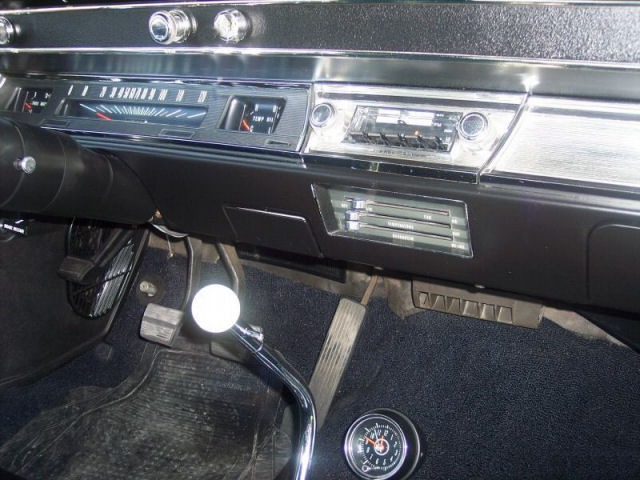
The standard cluster for 1967 changed with a couple of additions. The BRIGHT (high beam headlamps) indicator moved to the speedometer face with a small rectangle and now had a blue lamp instead of red. The two warning lamp cluster on the left remained OIL||TEMP but the right two warning lamp cluster changed to GEN||BRAKE as the brake warning was now standard.
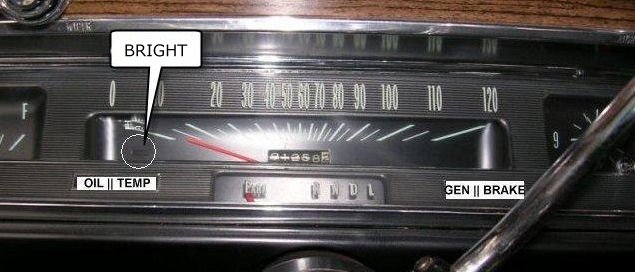
Essentially the same three cluster types as shown at the top of the page for 1966 also applied to 1967 with the exception of these two warning lamp changes.
Although the part numbers changed for the RPO U14 cluster between 1966 & 1967, outwardly they changed very little. The 1967 version looked pretty much the same as the 1966 version to the driver. The 1967 version DID NOT have the BRIGHT warning lamp in the location shown above but rather moved the BRIGHT warning lamp to the OIL||TEMP area and the BRAKE warning lamp remained in the right-most location but without the GEN warning lamp.
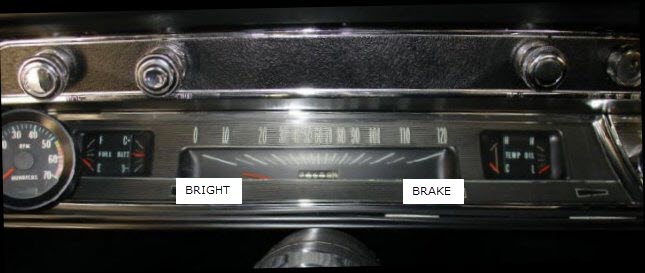
The spacing of the speed indicating numbers changed noticeably between 0-10, 10-20, 100-110, and 110-120. Note on the 67 cluster above the 10 and 110 and compare them to the 66 cluster below. Also note the 67 cluster above has tick marks for every 5 mph where the 66 below does not have tick marks for 5, 15, 105, or 115 mph.

The tachometer was also part of the RPO U14 Special Instrumentation package but could be ordered separately under RPO U16 just as it could in 1966 but moved from below the dash to the top left of the dash.
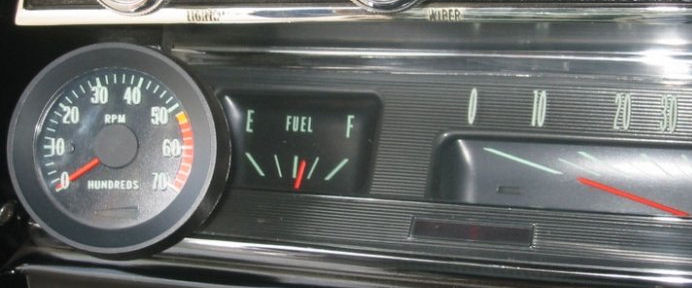
The location moved from the lower part of the dash panel to the instrument panel so it was more visible and in the driver's line of sight. Unfortunately the tachometer was also smaller and arguably harder to read. Since the location blocked the left turn indicator lamp, this lamp was placed in the bottom of the tachometer earning it the nickname "blinker" tach and, like 1966, was available on any V8 series or model with a V8 engine.
 Home
Home Decode
Decode Tech
Tech Tools
Tools My Books
My Books Contact
Contact Chevelle
of the Month
Chevelle
of the Month Things
For Sale
Things
For Sale